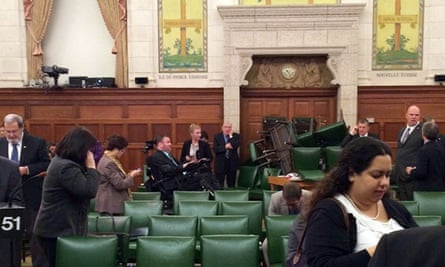Canada’s prime minister, Stephen Harper, hid in a cupboard used to store electrical boxes and a ladder while a gun battle ensued in a nearby hallway of the parliament building in Ottawa this week, it emerged on Friday.
Members of parliament and party leaders including Harper were meeting in the centre block of Parliament Hill when the attacker, Michael Zehaf-Bibeau, stormed into the building at about 10am on Wednesday morning.
Officers from the Royal Canadian Mounted Police (RCMP) trailed Zehaf-Bibeau as he rushed up the steps to the main entrance of the Centre Block.
As he entered the building, parliamentary security guards opened fire on Zehaf-Bibeau, a petty criminal with a history of mental illness, brandishing a 30-30, lever-action Winchester rifle that he’d moments ago used to kill Nathan Cirillo, an honor guard on duty at the nearby National War Memorial.
Meanwhile, Harper was hiding in a storage closet just steps away from the Conservative caucus’s meeting room, sources confirmed to the Globe and Mail on Friday. Harper’s security detail was not with him at the time.
The RCMP commissioner, Bob Paulson, said a “multitude of shots” were fired during the exchange. A guard was shot in the leg as the gunmen rushed through the marble-lined hallway.
At some point Kevin Vickers, the house of commons sergeant-at-arms, emerged with a pistol he retrieved from a lockbox, and engaged Zehaf-Bibeau as the pair of them darted behind pillars. In the rapid exchange, the gunman was struck and slumped to the ground. Vickers is widely credited with preventing a further tragedy by rapidly engaging Zehaf-Bibeau, who was pronounced dead at the scene. Vickers then rushed to ensure Harper’s safety.

The RCMP commissioner said the exact details of the battle between Zehaf-Bibeau, parliamentary security guards and RCMP officers were still under investigation.
Shortly after the incident, Harper was hustled out of the building to a secure location. Some members of parliament said they were shocked when he climbed out of his modest hiding place, the Globe and Mail reported.
That a gunman made it so close to the prime minister and MPs has raised serious security concerns. Paulson confirmed on Thursday announced a change to the security detail to ensure the prime minister would not be placed in such a situation again.
“I can tell you that now we’ve adopted a condition where we will stay with the prime minister in the prime minister’s protective detail 24/7, no matter where he is,” said Paulson.
Although the chain of events lasted just minutes, the area remained in lockdown for hours, with the last group allowed to leave more than 12 hours after the shooting began.
There were reports of multiple shooters, and it took police hours to sweep the premise, Ottawa police chief Charles Bordeleau said on Thursday. He said police had received emergency calls that there was a shooting in a shopping mall, the Rideau Centre, which turned out later to be false.
“Before we can discount any information, we have to verify it,” Bordeleau said, explaining why the area remained on lockdown for so long.
An urgent email sent to MPs and staff on Wednesday instructed them to lock or barricade their office doors, which they were not to open for anyone, and to stay away from windows. This later caused problems when the police swept the area and, not having keys to the offices, asked to be let in. Police rammed the doors of empty offices; reporters who toured parliament after the incident said several rooms were missing their doorhandles.
Parliament resumed on Thursday, a day after the attack, in a show of resilience by Canada’s politicians. The Canadian government indicated that it intends to speed up proposals to toughen the country’s anti-terror laws in the wake of the attack, including a measure that would allow “preventative detention”.
The governing Conservatives have made no secret of their plan to install new anti-terror powers, giving the Canadian Security Intelligence Service (CSIS) more powers to track, investigative and detain would-be homegrown terrorists. Harper promised the proposals would be brought forward.
“They need to be much strengthened, and I assure you, Mr Speaker, that work which is already under way will be expedited,” Harper told MPs on Thursday.
Details of those new powers have yet to be released, but justice minister Peter MacKay indicated to reporters that they will include measures to allow the preventive detention of suspected would-be terrorists.
“We’re examining all those sections of the criminal code, and all measures under the law that will allow us, in some instances, to take pre-emptive measures,” he said.

At Thursday’s parliamentary session, Vickers was honored with a standing ovation. An emotional Vickers thanked politicians and commended fellow guards and police officers for their swift action that brought the gunman’s rampage to an end.
“I am very touched by the attention directed at me following yesterday’s events,” Vickers said in a statement on Thursday. “However, I have the support of a remarkable security team that is committed to ensuring the safety of members, employees and visitors to the Hill.”
As sergeant-at-arms, Vickers is responsible for ensuring the “safety and security of the Parliament buildings and their occupants,” according to a release announcing his appointment in 2006, as well as carrying the ceremonial gold mace into the House of Commons before each sitting.
Vickers, 58, assumed the position after 29 years with the RCMP, during which he rose to the rank of chief superintendent. He had provided security detail for important guests, including the Queen and Prince Andrew.
“During extraordinary circumstances, security personnel demonstrated professionalism and courage,” Vickers said. “I am grateful and proud to be part of this team.”
Comments (…)
Sign in or create your Guardian account to join the discussion